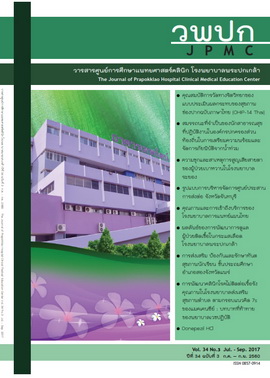คุณภาพและการเข้าถึงบริการของโรงพยาบาลการแพทย์แผนไทย
Main Article Content
Abstract
ที่มาของปัญหา: จากการที่กรมการแพทย์แผนไทยและการแพทย์ทางเลือกได้นำร่องการจัดบริการในรูปแบบของโรงพยาบาลการแพทย์แผนไทยที่มีบริการทั้งผู้ป่วยนอก ผู้ป่วยใน และเชิงรุกในชุมชน โดยให้ความสำคัญต่อการให้บริการเวชกรรมแผนไทย เน้นที่การตรวจวินิจฉัยและสั่งการรักษาทางการแพทย์แผนไทย โดยได้เริ่มดำเนินการในโรงพยาบาลของรัฐ 21 แห่ง จึงควรมีการศึกษาถึงคุณภาพบริการและการเข้าถึงบริการตรวจวินิจฉัยและจ่ายยาแผนไทย เพื่อเป็นข้อมูลในการพัฒนาขีดความสามารถของโรงพยาบาลการแพทย์แผนไทย
วัตถุประสงค์: เพื่อวัดระดับคุณภาพบริการการเข้าถึงบริการของโรงพยาบาลการแพทย์แผนไทย และศึกษาความสัมพันธ์ระหว่างคุณภาพบริการ การเข้าถึงบริการ และองค์ประกอบระบบสุขภาพ
วัสดุและวิธีการ: เป็นการศึกษาเชิงสำรวจโดยให้ผู้ใช้บริการตรวจวินิจฉัยและจ่ายยาแผนไทยที่โรงพยาบาลการแพทย์แผนไทย 12 แห่ง จำนวน 730 คน ตอบแบบสอบถามด้วยตนเอง ถึงคุณภาพบริการตามการรับรู้และการเข้าถึงบริการ และสัมภาษณ์ผู้อำนวยการและหัวหน้างานแพทย์แผนไทย โรงพยาบาลละ 2 คน เกี่ยวกับองค์ประกอบระบบสุขภาพ วิเคราะห์ข้อมูลด้วยการใช้สถิติเชิงพรรณนา และสถิติเชิงอนุมาน Kruskal Wallis ที่ระดับนัยสำคัญ 0.05
ผลการศึกษา: ผู้ใช้บริการมีความพึงพอใจต่อบริการโดยรวมในระดับสูง โดยมีประเด็นในการวัดความพึงพอใจ 5 ด้าน ได้แก่ การต้อนรับและซักประวัติ สถานที่นั่งคอย ห้องน้ำห้องส้วม บุคลากร และการบริการห้องยา โดยมีความพึงพอใจระดับสูงต่อบุคลากรที่ให้บริการมากที่สุด รองลงมาเป็นการบริการห้องยา การต้อนรับและซักประวัติ สถานที่นั่งคอย และห้องน้ำห้องส้วม ส่วนใหญ่ ใช้สิทธิในการรักษาพยาบาลได้ การเดินทางสะดวก บริการตอบสนองความต้องการได้ และคุณภาพบริการสม่ำเสมอ การเข้าถึงบริการของผู้ใช้บริการมีความ สัมพันธ์กับความพึงพอใจบริการ (p<0.05) ผู้ที่สามารถเข้าถึงบริการได้ง่ายกว่าจะมีความพึงพอใจต่อบริการมากกว่า และพบว่าองค์ประกอบระบบสุขภาพทุกด้านสนับสนุนการดำเนินงานโรงพยาบาลการแพทย์แผนไทย
สรุป: การใช้องค์ประกอบระบบสุขภาพในการวิเคราะห์และสนับสนุนการดำเนินงานส่งผลให้บริการมีคุณภาพและประชาชนสามารถเข้าถึงบริการได้
Quality and Accessibility of Thai Traditional Medicine Hospitals
Abstract
Background: The Thai traditional and alternative medicine department had piloted the services in the form of Thai traditional medicine hospitals with outpatients, inpatients, and proactive services in communities by focusing on the services of Thai traditional medicine, the diagnosis, and order of medical treatment was initiated in 21 hospital throughout the country. The quality of service and accessibility to the diagnostic and dispensary services of Thai traditional medicine should be studied in order to provide information for the development of the capabilities of Thai traditional medicine hospitalsObjectives: To measure service quality and accessibility to the services of Thai traditional medicine hospitals and the relationship between the service quality, accessibility and health system components.
Materials and method: This cross-sectional interviewed study on quality and accessibility to services was conducted among 730 clients attended at the diagnostic services and dispensary services of 12 Thai traditional medicine hospitals. The director and the head of the sampled Thai traditional medicine hospitals were also interviewed on the components of health system. Data analysis was performed by using descriptive statistics. For inferential statistics, Kruskal Wallis, was performed at 0.05 significant level.
Results: The clients were at a high level of overall satisfaction to diagnostic services and dispensary services. There were 5 dimensions of satisfaction to the services being measured: information and history taken, waiting room, rest room, personnel, and dispensary services. The highest of satisfaction was the personnel who provide services, followed by dispensary services, information and history taken, waiting room and restroom. The accessibility to services was rather good, the services can serve clients’ needs, and the service quality was rather consistent. The relationship between the accessibility to services and the clients’ satisfaction was significant (p<0.05), the clients who was easily access to the services were more satisfied to the service. All health system components supported the operation of Thai traditional medicine hospitals.
Conclusion: Using the health system components in analyzing and supporting the operations can enhance the quality of services, and people can access to the services more easily.
